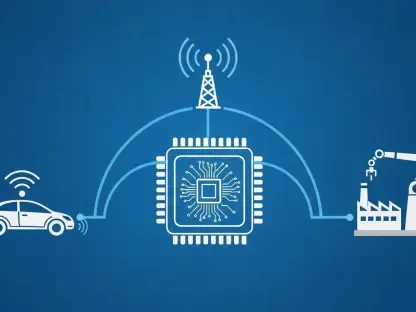Imagine a scenario where wireless connections remain unshakable, even amidst the chaos of a packed stadium during a championship game or on a factory floor buzzing with robotic activity, and this vision is no longer a distant dream but the core promise of Wi-Fi 8, the next frontier in networking technology. As digital demands escalate, with devices and applications requiring seamless connectivity for everything from entertainment to critical operations, the evolution of Wi-Fi standards has emerged as a pivotal force in technological advancement. This upcoming standard shifts the narrative away from merely chasing faster speeds and instead hones in on delivering unparalleled stability in the most demanding environments. Whether it’s powering industrial automation or enabling immersive virtual reality experiences, Wi-Fi 8 is set to redefine the benchmarks of wireless reliability. This article explores the journey of Wi-Fi technology, the current challenges with existing standards, and how this new iteration aims to address long-standing pain points with a focus on consistent performance. By delving into its anticipated features and transformative potential across various sectors, a clearer picture emerges of how this technology could shape the future of connectivity in ways previously unimagined.
Tracing the Path of Wi-Fi Advancements
The saga of Wi-Fi technology kicked off in 1997 with the introduction of the IEEE 802.11 standard, laying the foundation for wireless communication at a time when wired connections dominated. Early iterations, such as Wi-Fi 1 and Wi-Fi 2, were revolutionary for their era, offering basic internet access without cables. However, these early standards grappled with significant limitations, including frequent interference and restricted range, which often frustrated users seeking dependable connections. Each subsequent generation built upon these initial efforts, with Wi-Fi 3 and Wi-Fi 4 introducing marked improvements in speed and coverage that made wireless networks a staple in homes and small offices. These advancements catered to the growing appetite for streaming and online gaming, transforming how people interacted with technology on a daily basis. By the time Wi-Fi 5 arrived, the emphasis on higher throughput and multi-user capabilities supported the surge in high-definition content consumption, setting a new bar for what wireless networks could achieve in personal and professional spaces.
With the rollout of Wi-Fi 6, the focus pivoted to efficiency, particularly in high-density environments like airports, universities, and urban centers where numerous devices compete for bandwidth. This standard introduced technologies to better manage traffic, reduce latency, and conserve power for connected devices, addressing the needs of the Internet of Things era. Building on this, Wi-Fi 7 pushed the envelope further by prioritizing ultra-high speeds and minimal latency, targeting applications such as 8K video streaming and augmented reality. Despite these leaps, challenges in real-world deployment persist, revealing gaps between theoretical capabilities and practical outcomes. This historical progression underscores a consistent theme: each Wi-Fi generation adapts to the evolving demands of users, paving the way for the next leap forward with a nuanced understanding of past shortcomings and future needs.
Challenges Facing Wi-Fi 7 Deployment
Wi-Fi 7, introduced in 2024, arrived with much fanfare, promising groundbreaking features like wider frequency channels and multi-link operation to deliver unprecedented connection speeds. This standard has already shown potential in specialized sectors, enabling real-time data transmission in hospitals for critical medical applications and supporting high-speed internet at major transportation hubs. Such implementations highlight the technology’s capacity to handle demanding, niche use cases where low latency and high bandwidth are non-negotiable. Early adopters in industries like healthcare and logistics have reported significant improvements in operational efficiency, demonstrating that Wi-Fi 7 can indeed shine under controlled, optimized conditions. However, these successes are tempered by a broader reality that limits its transformative impact across more general applications and environments.
Despite its advanced capabilities, Wi-Fi 7 faces substantial hurdles that prevent widespread adoption and consistent performance. Spectrum limitations pose a significant barrier, particularly in regions where key frequency bands remain unallocated, restricting the standard’s ability to fully utilize its designed potential. Additionally, the high costs associated with manufacturing and implementing compatible hardware deter many consumers and businesses from upgrading. Compatibility issues further complicate deployment, as older infrastructure often fails to support the standard’s innovative features, leading to underwhelming results in real-world scenarios. These challenges reveal a disconnect between the impressive specifications touted by Wi-Fi 7 and the practical experiences of many users, underscoring the need for a shift in focus toward addressing environmental and systemic constraints in networking technology.
Shifting Priorities with Wi-Fi 8
Looking ahead to the expected standardization of Wi-Fi 8 by 2028, a notable departure from previous trends comes into view, with the technology prioritizing stability over sheer speed. Unlike earlier standards that chased ever-higher bandwidth numbers, this iteration targets a significant 25% improvement in throughput, reduced latency, and minimized packet loss, especially in complex and challenging settings. This pragmatic approach acknowledges that raw performance metrics mean little if connections falter under stress, such as in densely populated areas or during high-mobility scenarios. By focusing on reliability, Wi-Fi 8 aims to ensure that users experience consistent connectivity, regardless of external pressures, marking a strategic pivot in the evolution of wireless standards toward real-world applicability.
Key innovations underpinning Wi-Fi 8 include multi-access point coordination, which reduces interference by allowing multiple access points to work in harmony, and seamless roaming capabilities that maintain connections as users move across networks. These features are designed to eliminate the interruptions that plague current standards, offering a smoother experience in environments where reliability is paramount. This isn’t merely an incremental upgrade but a fundamental rethinking of Wi-Fi’s role in a world increasingly dependent on constant connectivity. By setting stability as the new benchmark, Wi-Fi 8 responds directly to user frustrations with dropped connections and inconsistent performance, positioning itself as a solution for both everyday and specialized networking demands in an era of relentless digital expansion.
Game-Changing Applications on the Horizon
Envision a smart factory where every robotic arm and sensor communicates flawlessly, executing precise tasks without a single delay or error in data transmission. Wi-Fi 8’s emphasis on stable, dependable connections makes such scenarios not just possible but practical, supporting industrial automation at an unprecedented scale. This technology enables real-time control and monitoring in environments where wired networks were once the only viable option due to reliability concerns. Industries such as manufacturing and logistics stand to gain immensely, as the ability to maintain uninterrupted wireless communication could streamline operations, reduce downtime, and enhance safety protocols. The implications extend beyond efficiency, potentially redefining how entire sectors approach infrastructure and connectivity challenges in dynamic, high-stakes settings.
Another transformative arena for Wi-Fi 8 lies in extended reality, commonly referred to as XR, encompassing virtual and augmented reality applications. By ensuring low latency and robust bandwidth, this standard could facilitate cloud-based XR experiences, reducing the need for expensive, heavy hardware and making immersive technologies more accessible. From gaming to professional training simulations, users could engage in seamless, high-quality interactions without the lag that disrupts current experiences. This opens up possibilities for widespread adoption in education, entertainment, and remote collaboration, where consistent performance is critical to user engagement. As XR continues to evolve, Wi-Fi 8’s role in supporting its growth highlights the standard’s potential to bridge technological gaps and democratize cutting-edge tools across diverse fields.
Enhancing Connectivity in Daily Scenarios
Beyond specialized industries, Wi-Fi 8 is poised to make a tangible difference in everyday public spaces where connectivity often falters under heavy demand. Consider large venues like stadiums, concert halls, or busy airports, where thousands of users simultaneously access the internet for streaming, navigation, or communication. The standard’s advanced traffic management and interference reduction capabilities could eliminate the frustrating buffering and dropped signals that are all too common in such settings. This means attendees at major events or travelers in transit hubs could enjoy a consistently smooth online experience, enhancing both convenience and satisfaction in environments that test the limits of current networking technologies.
The impact of Wi-Fi 8 extends to the broader population, touching anyone who depends on a stable internet connection in their daily routine. As digital interactions become more intricate—spanning remote work, smart home systems, and constant mobile usage—the need for a reliable wireless backbone grows ever more critical. This technology promises to support these complexities by ensuring that connectivity issues become a rarity rather than a regular annoyance. By weaving stability into the fabric of wireless networking, Wi-Fi 8 lays the groundwork for a future where digital interruptions no longer hinder productivity or leisure, quietly empowering users across all walks of life to navigate an increasingly connected world with confidence and ease.
Building a Robust Future for Networking
Reflecting on the trajectory of wireless technology, the strides made with each Wi-Fi generation have consistently aimed to address the pressing connectivity needs of their time. From the rudimentary access provided by early standards to the efficiency-driven focus of Wi-Fi 6, and the ambitious speed targets of Wi-Fi 7, each step tackled unique challenges. Wi-Fi 8, however, stands out by redirecting efforts toward stability, responding to the persistent frustrations of unreliable connections in demanding scenarios. Its introduction marks a pivotal moment where the industry acknowledges that consistent performance in real-world conditions outweighs theoretical peaks.
Looking ahead, the path forward involves not just anticipating the standardization of Wi-Fi 8 by 2028 but also preparing ecosystems to support its deployment effectively. Stakeholders across technology sectors should focus on aligning infrastructure, spectrum allocation, and device compatibility to ensure this standard achieves its full potential. Collaborative efforts among manufacturers, policymakers, and service providers will be essential to overcome the hurdles that limited prior generations. By investing in these foundational elements now, the groundwork can be laid for Wi-Fi 8 to deliver on its promise of transforming connectivity, from industrial powerhouses to everyday public spaces, ensuring that stability becomes the cornerstone of future digital experiences.









